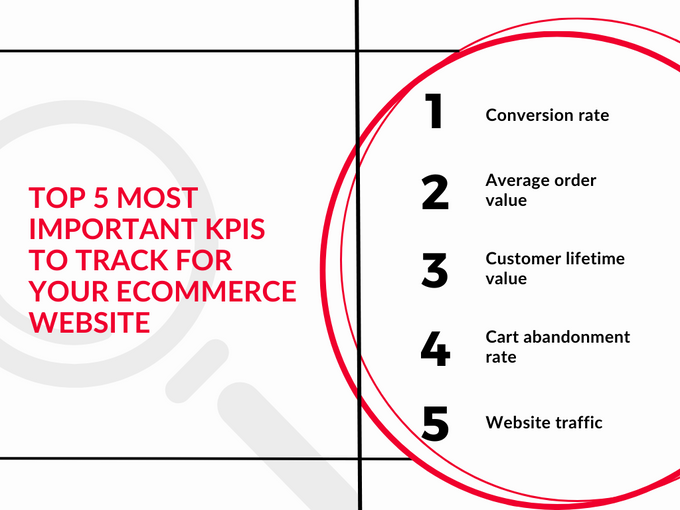Top 5 Most Important KPIs to Track for Your eCommerce Website
These are the key performance indicators to prioritize for a great store experience and increased sales.
Updated November 19, 2024

eCommerce is a competitive industry. But if you get it right, you stand to make a slice of the over $5 trillion in global e-tail sales. How do you make sure your online store is having an impact? You need to follow the numbers.
You can make data-driven decisions and improve your success by tracking the most important KPIs. It impacts your merchandising strategy and your marketing efforts. The good news is you don't need to keep tabs on every data point. Here are five essential metrics to bookmark today.
» Looking to try out new tactics? Check out how A/B testing can help.
Meet the Expert
Sandra Stepan, co-founder of SnapAdvantage, has 10 years in digital marketing, focusing on e-commerce expansion. With success in building 7-figure brands, she amplifies growth for top brands. An industry leader, Sandra is a trusted expert for marketing excellence.
What are eCommerce KPIs?
eCommerce KPIs, or Key Performance Indicators, are metrics that give you a quantitative snapshot of your online store's health and success. They're indicators of how effectively your business is converting visitors into customers, optimizing revenue, and ultimately growing. By keeping a close eye on these key KPIs, you get a look into your online store's weak spots and opportunities for improvement.
» Improving website search results is an important KPI to have to help improve revenue.
Top 5 Most Important KPIs to Track for Your eCommerce Website
There are plenty of metrics out there, but the ones we've highlighted below are important for eCommerce stores. That's especially true if you are just starting out. These measures can directly impact and measure your ability to attract new customers and keep existing ones engaged.
1. Conversion Rate
Your store might be getting traffic, but how many of those visitors are becoming customers? That's what your conversion rate measures. It tracks the percentage of website visitors who take a desired action, such as making a purchase or signing up for your email list. A high conversion rate means your website is effective at turning visitors into customers.
Conversion Rate = (Number of Conversions / Total Visitors) * 100
This metric speaks to the effectiveness of your website design, marketing strategies, product appeal, pricing strategy, and user experience.
To improve it, you might need to optimize your website design. Think about enhancing product descriptions, using a display merchandising optimizer, and providing social proof.
While the industry benchmarks for conversion rates typically range between 1% and 3%, improving the conversion rate can be challenging. It involves attracting high-quality traffic and maintaining a user-friendly site design. It also significantly impacts other metrics, such as the average order value (AOV) and customer lifetime value (CLV).
» Want to drive more sales? Here's how Fast Simon can help increase conversions.
2. Average Order Value
AOV is the average amount spent per order. It’s found by dividing total revenue by the number of orders in a certain time (like a day, week, month, or year).
AOV = Total Revenue / Number of Orders
A high AOV is generally considered to be good because it means customers are spending more each time they buy. This can boost your total revenue. But, a high AOV might also mean you’re getting fewer orders.
So, look at your AOV and other numbers like conversion rate and total orders to better understand your eCommerce performance.
Industry benchmarks vary widely based on product types and businesses. Here are some ways to improve your AOV:
- Offer product bundles or discounts for buying multiple items.
- Personalize your upsell and cross-sell on related products.
- Promote high-value products.
- Offer free shipping above a certain order value.
- Personalize your product recommendations
» Want to maximize your AOV? Check out this tool that can help with effective upsell and cross-sell.
3. Customer Lifetime Value
CLV is the predicted total revenue a customer brings in during their entire relationship with your store. It’s basically an estimate of how much each customer is worth to your business over their lifetime as a customer.
CLV = Average Purchase Value x Average Purchase Frequency Rate x Average Customer Lifespan
CLV is about more than just immediate sales. It predicts future value and helps you focus on keeping valuable customers. Knowing who your high-value customers are lets you personalize the eCommerce experience and use loyalty programs to keep them engaged.
Sudden, unjustified price increases can upset customers and lower this rate. To avoid this, be clear with your customers about any changes in pricing or products.
CLV benchmarks differ a lot. It depends on the type of business and customer buying habits. CLV is influenced by, and influences, AOV and customer retention rate.
4. Cart Abandonment Rate
The cart abandonment rate is the percentage of online shoppers who add items to their cart but leave before buying. It measures the missed sales when customers leave at checkout. Some businesses see rates up to 70%.
Cart Abandonment Rate = (1 – (Total Number of Completed Purchases / Total Number of Shopping Carts)) * 100
You can reduce cart abandonment by improving the store experience. This includes making checkout easy, improving search so customers can find and buy what they want, and better merchandising.
The cart abandonment rate greatly affects conversion rates and CLV.
» Looking to turn window shoppers into buyers? Check out how to reduce cart abandonment.
5. Website Traffic
Website traffic refers to the total number of visitors who come to your eCommerce website during a specific period. This can be measured in various ways, including:
- Unique visitors: the number of individual users who visited your site during a period.
- Total visits: the total number of times your website was accessed during a period, regardless of unique visitors.
- Page views: the total number of individual pages viewed on your site during a period.
- Sessions: the total number of browsing sessions on your website during a period, each defined by a period of inactivity.
Website traffic doesn’t always mean sales, but it shows your reach and potential audience. By looking at your traffic with conversion rate and bounce rate, you can see how well your website turns visitors into customers.
Google Analytics uses metrics like total visitors and unique visitors, page views and average session duration, traffic sources and channels, bounce rate, and conversion rate to show your traffic.
It is important to prioritize fast load times for a lowered bounce rate and a positive user experience.
There are no set benchmarks as it varies by industry and business model. Increased traffic can boost conversion rates and revenue, but consistent engagement can be challenging.
» Need to improve eCommerce conversion rates? Here's how AI helps
Getting Started: Prioritize These Metrics for Your eCommerce Store
For beginners setting up a new store, traffic and abandoned carts are the most important KPIs to focus on. Increased website traffic gives valuable data about user interests, which can inform ad effectiveness and help optimize landing and product pages.
Monitoring abandoned carts can offer insights into customer preferences and aid in refining ad strategies. Once enough data is collected over six to twelve months, consider optimizing for CLV and AOV.





